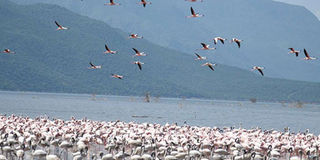Flamingo, geyser sceneries lure visitors to L. Bogoria

Flamingos create a beautiful scenery at Lake Bogoria, Baringo County, on July 5, 2019. PHOTO | FILE | NATION MEDIA GROUP
What you need to know:
- The Endorois community that lives around the lake uses the springs to heal illness like the common cold, asthma, skin ailments and eye problems.
- Just North of the Lake is Kesubo Swamp, an important wetland and a fascinating area for birdwatchers to visit as it has over 200 species.
Lake Bogoria in Baringo County is known for its geysers and flamingos.
But unknown to many are the “talking springs” of the lake which was listed as a World Heritage Site by the United Nations Educational, Scientific and Cultural Organisation (Unesco) in 2011. The lake is located about 60 kilometres from Nakuru town.
According to North Rift Economic Bloc Tourism Development Coordinator William Kimosop, the springs bubble at intervals of between 10 and 15 minutes.
“We usually guide tourists through the interesting spectacle by ‘talking’ to ‘resting’ springs to start shooting hot geysers. We promise them goodies, including wine, and they start bubbling vigorously,” said Mr Kimosop, adding that the lake has more than 200 hot springs.
He said the listing helped open the area to the outside world. Unesco said the lake was "valuable for the study of ecological processes".

Local tourists witness hot springs at Lake Bogoria, in Baringo County, on January 26, 2017. PHOTO | FILE | NATION MEDIA GROUP
When Bishop James Hannington first saw Lake Bogoria while enroute to Uganda in 1885, he termed it “the most beautiful view in Africa”.
“With the backdrop of the Eastern Wall of the Great Rift Valley, it is a stunning beauty that has always enchanted visitors. A great heritage which should be preserved,” he wrote.
HEALING POWER
Count Teleki and Colonel Von Hohnel camped at the site in 1887 while looking for Lake Turkana.
The park surrounding the water mass, Lake Bogoria National Reserve, has wild animals such as buffaloes, elands, water-bucks, rhinos, zebras, wildebeests, greater kuddus and ostriches.
In the 1950s, the late Leslie Brown, a provincial administrator and naturalist, became the first biologist to study the Lesser Flamingos of Lake Bogoria.
The hot springs on the lake are said to be therapeutic. The Endorois community that lives around the lake uses the springs to heal illness like the common cold, asthma, skin ailments and eye problems.
“The water also beautifies the skin and rids it of marks and spots,” Mr Wilson Kipkazi, an elder, told the Nation.
Researchers say the steam relieves arthritis, rheumatism, stiff joints, muscular pain and tension.
Just North of the Lake is Kesubo Swamp, an important wetland and a fascinating area for birdwatchers to visit as it has over 200 species.
TOURISM
The county expects to receive over 150,000 tourists by the end of this year, up from 105,000 last year. Most of the tourists come from China.
Experts estimate that Lake Bogoria hosts half of the world’s flamingos, thanks to the migration of more than a million birds from Lake Natron in Tanzania in July. The phenomenon has boosted tourism.
According to Mr James Kimaru, a senior game warden at Lake Bogoria National Reserve, the spectacle has attracted tourists from across the world.

Tourists enjoy quality time watching flamingos at Lake Bogoria, Baringo County, on August 25, 2017. PHOTO | FILE | NATION MEDIA GROUP
He said most tourists from the United Kingdom, Europe, Germany, Italy, France, US, China and Korea visit to watch birds.
“The flamingos arrived after breeding in Lake Natron. They are all pink and the young ones are quite a number, an indication that good breeding took place,” said Mr Kimaru.
“Plans are underway to conduct a census of birds in lakes Bogoria and Baringo this month to ascertain their number and also sell the region as a birding destination. This will be done in collaboration with Nature Kenya, Kenya Wildlife Service, Bird Life International, tour companies and hoteliers," he said.
BREEDING
According to the warden, the birds migrate to Tanzania for breeding in November and come back in mid-June.
“Lake Bogoria is a birding destination. And apart from the flamingos, we also have more than 373 bird species, 50 of which are migratory,” he said.
Hotels and other businesses adjacent to the reserve have been making a killing with requests for accommodation at Lake Bogoria Spa Resort skyrocketing.
Mr Kimaru said that both the Greater and the Lesser flamingos are found at the lake.
Is there a site you want us to feature? Write an e-mail to [email protected]





